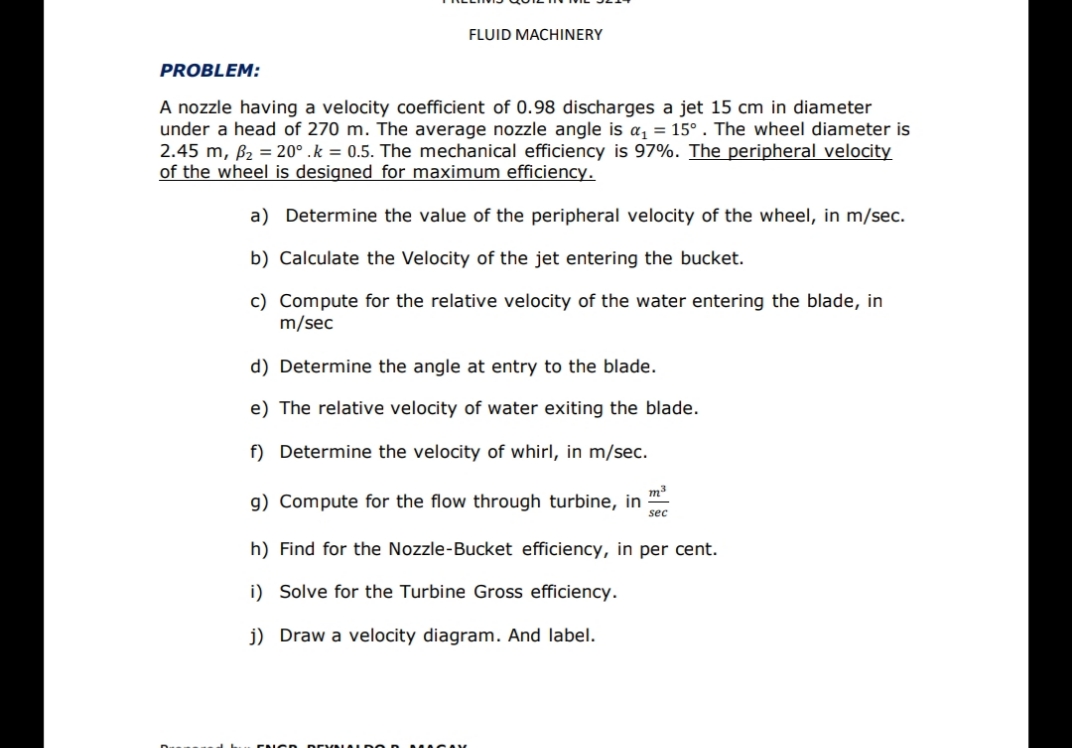PROBLEM: A nozzle having a velocity coefficient of 0.98 discharges a jet 15 cm in diameter under a head of 270 m. The average nozzle angle is a, = 15°. The wheel diameter is 2.45 m, B2 = 20° .k = 0.5. The mechanical efficiency is 97%. The peripheral velocity of the wheel is designed for maximum efficiency. a) Determine the value of the peripheral velocity of the wheel, in m/sec. b) Calculate the Velocity of the jet entering the bucket. c) Compute for the relative velocity of the water entering the blade, in m/sec d) Determine the angle at entry to the blade. e) The relative velocity of water exiting the blade.
PROBLEM: A nozzle having a velocity coefficient of 0.98 discharges a jet 15 cm in diameter under a head of 270 m. The average nozzle angle is a, = 15°. The wheel diameter is 2.45 m, B2 = 20° .k = 0.5. The mechanical efficiency is 97%. The peripheral velocity of the wheel is designed for maximum efficiency. a) Determine the value of the peripheral velocity of the wheel, in m/sec. b) Calculate the Velocity of the jet entering the bucket. c) Compute for the relative velocity of the water entering the blade, in m/sec d) Determine the angle at entry to the blade. e) The relative velocity of water exiting the blade.
Elements Of Electromagnetics
7th Edition
ISBN:9780190698614
Author:Sadiku, Matthew N. O.
Publisher:Sadiku, Matthew N. O.
ChapterMA: Math Assessment
Section: Chapter Questions
Problem 1.1MA
Related questions
Question
Fluid machinery

Transcribed Image Text:FLUID MACHINERY
PROBLEM:
A nozzle having a velocity coefficient of 0.98 discharges a jet 15 cm in diameter
under a head of 270 m. The average nozzle angle is a, = 15° . The wheel diameter is
2.45 m, B2 = 20° .k = 0.5. The mechanical efficiency is 97%. The peripheral velocity
of the wheel is designed for maximum efficiency.
a) Determine the value of the peripheral velocity of the wheel, in m/sec.
b) Calculate the Velocity of the jet entering the bucket.
c) Compute for the relative velocity of the water entering the blade, in
m/sec
d) Determine the angle at entry to the blade.
e) The relative velocity of water exiting the blade.
f) Determine the velocity of whirl, in m/sec.
m3
g) Compute for the flow through turbine, in
sec
h) Find for the Nozzle-Bucket efficiency, in per cent.
i) Solve for the Turbine Gross efficiency.
j) Draw a velocity diagram. And label.
Expert Solution
This question has been solved!
Explore an expertly crafted, step-by-step solution for a thorough understanding of key concepts.
Step by step
Solved in 4 steps with 1 images

Knowledge Booster
Learn more about
Need a deep-dive on the concept behind this application? Look no further. Learn more about this topic, mechanical-engineering and related others by exploring similar questions and additional content below.Recommended textbooks for you

Elements Of Electromagnetics
Mechanical Engineering
ISBN:
9780190698614
Author:
Sadiku, Matthew N. O.
Publisher:
Oxford University Press

Mechanics of Materials (10th Edition)
Mechanical Engineering
ISBN:
9780134319650
Author:
Russell C. Hibbeler
Publisher:
PEARSON

Thermodynamics: An Engineering Approach
Mechanical Engineering
ISBN:
9781259822674
Author:
Yunus A. Cengel Dr., Michael A. Boles
Publisher:
McGraw-Hill Education

Elements Of Electromagnetics
Mechanical Engineering
ISBN:
9780190698614
Author:
Sadiku, Matthew N. O.
Publisher:
Oxford University Press

Mechanics of Materials (10th Edition)
Mechanical Engineering
ISBN:
9780134319650
Author:
Russell C. Hibbeler
Publisher:
PEARSON

Thermodynamics: An Engineering Approach
Mechanical Engineering
ISBN:
9781259822674
Author:
Yunus A. Cengel Dr., Michael A. Boles
Publisher:
McGraw-Hill Education

Control Systems Engineering
Mechanical Engineering
ISBN:
9781118170519
Author:
Norman S. Nise
Publisher:
WILEY

Mechanics of Materials (MindTap Course List)
Mechanical Engineering
ISBN:
9781337093347
Author:
Barry J. Goodno, James M. Gere
Publisher:
Cengage Learning

Engineering Mechanics: Statics
Mechanical Engineering
ISBN:
9781118807330
Author:
James L. Meriam, L. G. Kraige, J. N. Bolton
Publisher:
WILEY